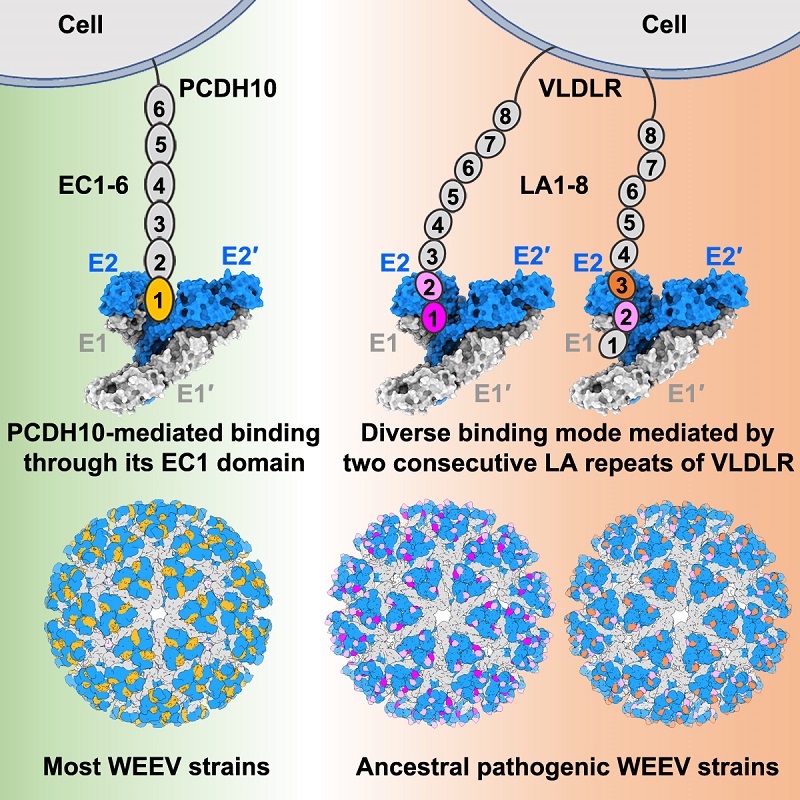Structural Insights Reveal How Western Equine Encephalitis Virus Engages Host Receptors for Cell Entry
Western equine encephalitis virus (WEEV), a mosquito-borne alphavirus, can cause fatal encephalitis in humans and equines. After decades of dormancy, a sudden WEEV outbreak occurred in South America during 2023-2024, raising renewed global public health concerns. WEEV strains exhibit significant differences in their preferences for host cell receptors. This variability in receptor usage suggests that WEEV may have evolved receptor-shift mechanisms to facilitate infection and invasion across diverse host species. However, the specific molecular mechanisms behind this adaptation have remained unclear.
On May 20, 2025, a joint study led by researchers from the Institute of Biophysics of Chinese Academy of Sciences, and Tsinghua University, published in Cell Reports, reveals that WEEV exploits distinct binding strategies to attach to host cells.
In this study, researchers systematically resolved high-resolution cryo-electron microscopy (cryo-EM) structures of various WEEV strains in complex with two distinct receptors: protocadherin 10 (PCDH10) and very low-density lipoprotein receptor (VLDLR).
The study revealed that these two receptors form entirely different binding interfaces and recognition patterns on the WEEV surface. These findings provide a detailed structural and molecular basis for receptor switching in WEEV and offer important theoretical insights for the prevention and control of alphaviruses.
The researchers found that the EC1 domain of PCDH10 is deeply embedded in the cleft formed between adjacent E2-E1 heterodimers within the viral glycoprotein trimer and engages in multiple interface interactions with E2, E1, and the neighboring E2' glycoprotein.
Further analysis revealed that the Imperial 181 strain carries an L149Q mutation in the E2 glycoprotein, which inhibits the binding between this strain and human-derived PCDH10.
In contrast, avian-derived PCDH10 contains a Q107R mutation that compensates for the impact of the L149Q mutation in the viral E2 glycoprotein, thereby maintaining stable interactions between the virus and the avian receptor.
Therefore, the selective recognition of PCDH10 receptors from different species by WEEV strains is jointly determined by key amino acid sequence variations in both the viral glycoprotein and the host receptor.
The study also found that VLDLR binds the WEEV McMillan strain through two consecutive low-density lipoprotein receptor class A (LA) repeats, with LA1-2 to LA5-6 all exhibiting detectable binding capabilities. The interaction primarily relies on the basic lysine side chains on the viral surface, which interact with the conserved acidic calcium-binding sites in the LA domains.
Results indicate that the multi-repeat LA binding mode of VLDLR depends on specific basic amino acid residues on the viral surface. These critical residues can be gained or lost during viral evolution, which explains the differing abilities of various WEEV strains to utilize VLDLR. This also highlights the considerable variability in VLDLR-like receptor-dependent viral entry and provides important clues for the development of antiviral strategies.
By resolving the high-resolution structures of different WEEV strains bound to two distinct types of receptors, this study elucidates the structural basis and specificity determinants of receptor switching in WEEV. The findings significantly advance our understanding of alphavirus host adaptation, cross-species transmission, and antiviral intervention development.

Figure. The selective recognition of different receptors by various WEEV strains
(Image by ZHANG Xinzheng's group)
Article link: https://www.cell.com/cell-reports/fulltext/S2211-1247(25)00495-4
Contact: ZHANG Xinzheng
Institute of Biophysics, Chinese Academy of Sciences
Beijing 100101, China
E-mail: xzzhang@ibp.ac.cn
(Reported by Prof. ZHANG Xinzheng's group)

